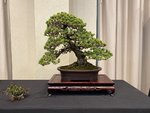M. Frary
Bonsai Godzilla
You know I would. They don't intimidate me and they may learn something about trees from me. No matter what you think they aren't the last word in bonsai. Nobody is.NOTHING to be jealous of! Maybe you might take personal arrogance and argue point with Ryan Neil? Randy Knight? Walter Pall?
They see beauty you refuse to see. I also see.
Beauty is in the eye of the beholder.
Ponderosa pines are fine for their bark but the foliage is too much.
I've actually been thinking of trying a ponderosa to graft Scots pine foliage onto.
It isn't Japanese foliage but it still isn't from here. Europe.
But on second thought why screw up a good Scots pine just to make a ponderosa look better.
I'll just leave them things to the people who think they are good for bonsai.
I talked to John Wall about this very thing last year when I suggested his demonstration RMJ would be so much better with shimpaku foliage grafted on it. He said some people actually like the long wispy foliage but he saw where I was coming from.
For me it's all about the image. The tree should have the smallest foliage possible to be in scale. No trees except for seiju elm even come close. Ponderosa pine foliage isn't even in the conversation. May as well have an Eastern White Pine.
Japanese Black pine,Scots pine and Mugo pine can all have their needles reduced dramatically.





